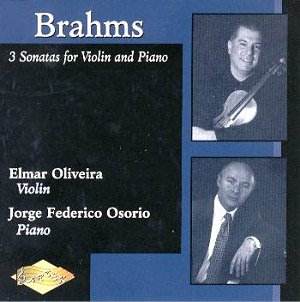There must be over fifty different recordings of Brahmsí
D minor Violin Sonata alone in the catalogue, beginning with Isolde
Menges and Harold Samuel in 1929 (on Biddulph if you can find it though
itís on an Italian pirate label as well). But thereís always room for
an intelligent and tonally vibrant set, such as Oliveira and Osorio
provide. In the first movement of the G major it is instructive to observe
how they prefer expressive and emotive shading to more obvious metrical
displacements and tempo changing. This imparts a seamlessness to their
performance if perhaps at times a rather unyielding one. Osorio is on
fine form in the Adagio, weighting his chords aptly and Oliveira catching
the glinting, shifting profile of the violinís line. The finale is steady,
Oliveira playing with soaring caution, bringing the movement to a peak
of lyrical intensity at 5.30 with some dramatically urgent and opulent
tonal resources. Theyíre not as taut here as the famous oft-quoted Suk-Katchen
duo but are strongly convincing on their own terms.
The difficult Second (difficult because itís hard successfully
to convey its sometimes elusive meaning) receives a dramatic interpretation.
This is strong on luscious tonal expressivity, strongly etched and committed,
a very exterior traversal. Thereís much variation of vibrato usage from
Oliveira and also some pungent chording from Osorio. In the slow movement
in particular Oliveira digs into considerable reserves of lavished intensity,
utilising the arsenal of devices open to a tonalist of stature to inflect
and deepen the line. The gracious finale still has in their hands a
steady, cumulative power to it. The D minor once more exemplifies Oliveira
and Osorioís drama and power-laced aesthetic in these works. The Allegro
is strong and powerful, the Adagio structurally acute, Oliveira reserving
emotive intensity for the optimum structural moment, which is not -
pace certain well known fiddle players - too early. He manages
to highlight lyric phrases adeptly and is not inclined to use his vibrato
as a sauce. The third movement is elegant, wistful with just the right
note of lightness and movement, the finale strong and courageous.
The acoustic can, itís true, impart some edginess to
Oliveiraís tone though the balance itself is just. Fortissimi are also
inclined to be steely but this is reflective as much of the strength
of the performances Ė which are recommended to those who enjoy high
octane Brahms sonatas.
Jonathan Woolf

